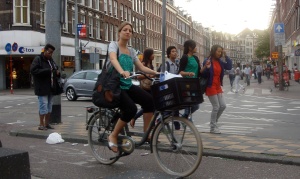Recently, Michael Pershan has been thinking about why it’s so hard for teachers to share knowledge and ideas. He has been playing with building cases to discuss as teachers, wondering about what counts as sufficient description to invite consultation.
In my work, I find that one of the challenges to building shared professional knowledge comes from the irreducible situativity of teaching. If that sounds like an academic mouthful, my apologies. But what I mean is that we can’t escape how much of what works in teaching comes out of nuances of our practice and resources in our context that we may not even be aware of. Just as fish don’t see the water they swim in, so too teachers often miss things like community norms or material resources that shape what is possible in the classroom.
In addition, I think the relational part of teaching has been understudied –– especially in mathematics education. As I have said before, asking students to share their thinking is a socially risky proposition and depends on the relationships in the classroom and the norms for participation.
Here is Courtney Cazden on this:
“In more traditional classrooms, social relationships are extracurricular, potential noise in the instructional system and interference with ‘real’ schoolwork. What counts are relationships between the teacher and each student as an individual, both in whole-class lessons and in individual seat-work assignments. In nontraditional classrooms, the situation has fundamentally changed. Now each student becomes a significant part of the official learning environment for all the others” (2001, p. 131)
So to get students to share their ideas, teachers have to attend not only to their individual relationships with students, but to students’ relationships with each other.
This is decidedly challenging work. Most classroom teaching situations exhibit tremendous relational density. As Philip Jackson observed decades ago, classrooms are among the most crowded of institutional settings. In order to function, they require some degree of cooperation from the students. Teachers often achieve that through setting up systems of compliance, by building relationships with students, or some combination of the two.
Although students who have an instrumental view of schooling are less dependent on a teacher’s relational skills, a teacher’s success often depends on engaging and shaping students’ sense of purpose.
But the relationships in the classroom do not simply exist between the teacher and students; they exist among the students themselves. Once we take this into account, the social complexity of the classroom is stunning. Instead of just seeing the relationship one teacher builds with each student, we must account for the combinations of relationships among the students themselves. As a consequence, the difference between having 16 students or 32 students in a classroom does not simply double the relational density of a classroom: each set of students has potential for harmony or conflict. Just considering the smaller class of 16, there are 120 possible pairings between students. In the larger class of 32, there are 496. The number of students only doubled, but the relational complexity has more than tripled.

Figure 1. Student pair-wise relationships grow quadratically while the class size grows linearly. The red dots represent students, and the connecting lines represent potential relationships.The last diagram represents the relationships among 5 students and a teacher, illustrating the fast growing relational density with every added student.
Relational density serves as a backdrop of potentialities in classrooms: not all relationships are actively engaged. When I talk to experienced teachers, however, I notice that they are alert to the relational potentials across the classroom social network, usually framing them as classroom dynamics.
Returning to Michael Pershan’s question, how do we adequately capture these dynamics when we describe our teaching situations? Some teachers talk about the kids with “strong personalities” or “the quiet kids.” I have heard teachers talk about students who are hot spots in the classroom relational network: most other students have an active experience of liking or disliking them. These experienced teachers respond by building lessons with their hotspot students in mind, anticipating possibly corrosive behavior or harnessing potential leadership.
Obviously, not all teachers attend to classroom dynamics in this way. Whether or not these dynamics are on a teacher’s radar, they contribute to the situativity of teaching. That is, we can’t really talk about teaching without addressing some of these particulars. Inattention to details of a teaching situation leads to invisibility in critical aspects of the work. This makes knowledge sharing hard.
So the question is: what sufficiently describes the character and dynamics of one situation to help teachers productively compare it to another? Often, teachers fall into language that relies on stereotyped understandings: an urban school, an honors class, an ADHD kid. These everyday categories stand in for broader dynamics but, in my view, do not adequately describe teaching situations.
Yet leaving critical dimensions of teaching situations underspecified contributes to the lack of consensus around expertise. What constitutes successful teaching remains hotly contested, evidenced by policy debates around standardized testing and value-added models of teaching. Grossly underdescribing teaching situations has led to an overdetermination of desirable, visible outcomes like test scores. In this way, invisibility creates a reliance on other kinds of representations of the work when communicating about instruction.





